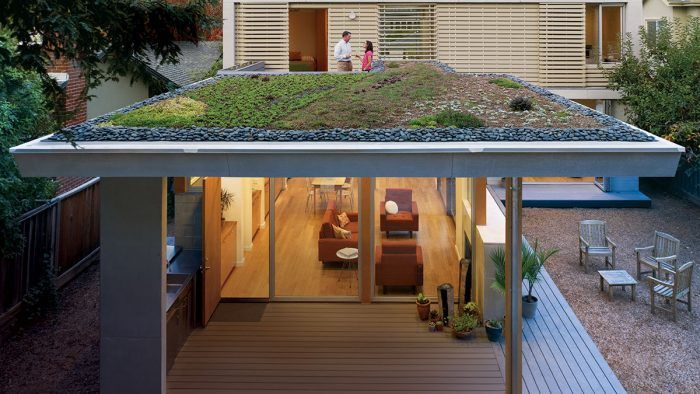An Inside Look at Living Roofs
If you follow this approach toward energy savings, storm-water control, and progressive design, you had better get the details right.

Synopsis: Studies on living roofs have shown that they provide a number of economic, aesthetic, and environmental benefits when designed and built properly: reducing annual heating and cooling costs, extending the life of the roofing material below the soil and plants, improving air quality, reducing outside noise, and controlling storm-water runoff. Author Roxi Thoren, an assistant professor of architecture and landscape architecture at the University of Oregon, explains how the layers of a living roof work together in a system. She discusses the options for waterproofing membranes, lists three ways of insulating a living roof, and discusses soil retention and drainage on sloped roofs. A sidebar describes three ways of building a living roof with modular products.
For anyone who has fought moss growing on a shady roof, the idea of intentionally planting a living roof may seem odd, but living roofs make a lot of sense on many homes. A living roof, also referred to as a vegetative or green roof, is a layer of soil and plants installed over a waterproof roof system. There is a long-standing history of living-roof performance that should help to put skeptics at ease. For example, turf houses in Scandinavia have used thick layers of soil and grass to insulate wood-framed homes for centuries. Contemporary living roofs, developed mostly in Germany beginning in the 1970s, also have a successful history. Germany has had living-roof standards since 1995, and some living roofs there have been in service for more than 30 years. Studies on those roofs have shown that they provide a number of economic, aesthetic, and environmental benefits when designed and built properly.
The energy factor

For many, interest in living roofs is based in part on their aesthetic appeal and in part on their environmental benefits. But the decision to install a roof that can cost $10 to $40 per sq. ft., depending on soil depth and roof design, should also be influenced by the economic and energy-related benefits.
The most direct benefit of a living roof is a potential reduction in annual residential heating and cooling costs. Living roofs act as an additional layer of insulation on top of a house. Their insulating impact on home energy consumption isn’t universal, however. Living roofs provide higher energy savings in summer than in winter, making them particularly useful in hot regions of the country. During the summer, plants shade the soil, and the soil absorbs moisture, which helps to reduce solar-heat gain in the home and reduces cooling needs by up to 25%. In the winter, soil and evergreen plants, which trap pockets of air, act as additional insulation. Plants also tumble air as it moves over the roof, reducing convective heat loss due to wind. While the benefits of a living roof are less dramatic in winter than they are in summer, studies have shown that living roofs can reduce wintertime energy use in the top floors of a house by up to 12%. While the energy-related attributes of a living roof in a heating-dominated climate may not be of primary significance, there are other benefits to consider as well.
Benefits beyond the house
Living roofs last a long time and reduce the impact of individual homes on their surrounding sites and communities at large. The soil and growth medium on a living roof nearly doubles the life of the roofing material below it. The roof is protected from sunlight, which degrades most roofing materials, and from physical damage due to falling branches or wind-borne debris.
For more photos, drawings, and details, click the View PDF button below:
Fine Homebuilding Recommended Products
Fine Homebuilding receives a commission for items purchased through links on this site, including Amazon Associates and other affiliate advertising programs.

Flashing Boot

Shingle Ripper

Ladder Stand Off





